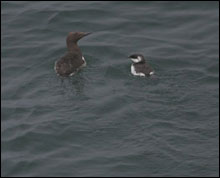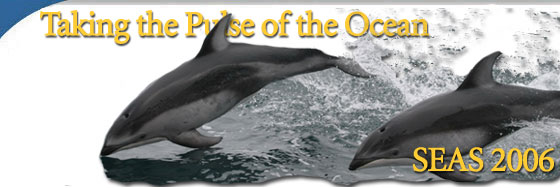|
Naturalist Notes
Marine Mammal Sightings: California sea lion, blue whale, killer whale
Featured Marine Mammal:
Northern right whale dolphin, Lissodelphis borealis
During this voyage, just after dawn as our night shift concluded, we witnessed a phenomenal spectacle: thousands of northern right whale dolphins crossed our starboard bow, then turned and raced ahead of us, some hanging back to ride our bow wave. The estimated total group size was 4,000 animals.
 |
| Northern right whale dolphin. |
This swift, graceful, elegant dolphin appears to be created by an Art Deco artist. Its sleek, streamlined black and white body, up to ten feet in length, is distinctive in lacking a dorsal fin. Traveling in herds ranging into the thousands, they may put on a synchronized swimming display, speeding off in long, low, arching leaps, this was amazing to see.
They range from Baja California to British Columbia, usually in cool, deep offshore waters where they feed primarily on squid and lanternfish. Although abundant within their range, they are hunted in Japanese shore fisheries and at risk from entanglement in drift nets.
Seabird Sightings: double-crested cormorant, pigeon guillemot, Caspian tern, tufted puffin
Featured Seabird: Common Murre, Uria aalge
 |
| Common Murre Male & Chick (Photo: Sophie Webb) |
A dark brown and white penguin-shaped seabird, the common murre nests on rocky cliffs and offshore islands along the Northern and Central California coast. The female lays a single large, speckled blue egg. The egg is rounded at the bottom so if disturbed, it will spin rather than roll off the ledge. The egg is about a third of the female's body size, and upon hatching, both parents feed the chick in the nest. Upon fledging the nest, the still-flightless murre chick follows its father down the precipitous cliff face, hurtling into the sea where its dad will coach it until it is proficient at foraging. During this cruise, we encountered some of this year's father-chick pairs.
This map summarizes where we found common murres and their chicks. Dots represent sightings (the presence of one or more) of an adult or immature bird, along with a chick. It is assumed that a chick is paired with its father. Some data points are not available due to weather. Data collection was compromised due to heavy fog on the following days: July 12, 13, 14 and 15. The adult murres without chicks are found along the outer continental shelf and along the continental slope, foraging over deeper water. The adults with chicks are found over the shelf (shallower) waters and closer into shore.
Murres dive hundreds of feet below the surface in pursuit of prey, unaffected by the water pressures at those depths. Unfortunately, this has made them susceptible to entanglement in fishing nets. Also, because murres habitually sit on and dive below the ocean surface, they are especially susceptible to fouling by oil, which mats their feathers, exposing them to cold and death. Common murres are of particular concern to sanctuary management due to historical population declines caused by egg harvesting, entanglement in gill nets and oil spills. Currently, there are approximately 160,000 nests on the Farallon Islands.
Marine Mammal Sightings: Pacific white-sided dolphin, northern right-whale dolphin, harbor seal
Featured Marine Mammal:
Risso’s Dolphin, Grampus griseus
When wildlife observers shout, “Grampus! Grampus!” watch for a large, scarred dolphin – the Risso’s dolphin.
Risso’s dolphins primarily are found in warm temperate waters in search of their favorite prey, squid. They sometimes forage in ocean depths exceeding 1,000 feet, making sanctuary waters a prime Risso’s dolphin habitat.
 |
| The Risso’s Dolphin pod’s long, falcate (curved) dorsal fins slice through the water’s surface. (Photo: Gary Friedrichsen) |
Often seen in groups of 25 or more, the Risso’s dolphin has a distinctive beakless, large bulbous head and darkish eye patch, giving it a comical appearance. Its lips form a perennial impish grin, with a mouth slanting upward toward its eyes. The Risso’s dolphin can reach 13 feet in length; have a tall, erect dorsal fin and body color ranging from pale beige to charcoal, depending on age. Numerous scars on the back and sides may be from other Risso’s dolphins or squid encounters. Older individuals may appear almost white. Though not endangered, Risso’s dolphins are frequent bycatch victims of fishing nets and longline fisheries.
During this voyage, we have observed several groups of Risso’s dolphins sprinting toward our ship for a closer look, frolicking in the water.
Seabird Sightings: red-necked phalarope, rhinoceros auklet, Brandt’s cormorant, South Polar skua, pomarine jaeger, parasitic jaeger, least sandpiper, marbled godwit, Heermann’s gull, brown pelican, California gull, Sabine’s gull, pelagic cormorant
Featured Seabird: Sooty Shearwater Puffinus griseus
Sooty Shearwater (Puffinus griseus)
During the past three days of our journey, we have encountered numerous “sooties.” Sooty shearwaters, the most abundant seabird in the California Current, numbering in the hundreds of thousands, are creatures built for long distance migration via dynamic soaring. Their long, slender wings permit them to skim the ocean surface uplifted on a cushion of air.
 |
| Sooty Shearwaters. (Photo: Anne Douglas) |
The timing of their visit coincides with the upwelling season. Upwelling occurs off our coast during months March through August when colder nutrient-rich waters rise and mix with warmer surface waters, triggering an explosion of planktonic (food!) life. This nearly eight thousand miles transpacific journey takes them only two weeks to complete. Shearwaters breed on islands off New Zealand and South America, and come here to the “lunch bucket” of the Northern Hemisphere – Cordell and Gulf of the Farallones National Marine Sanctuaries, to feed. In late summer and fall, they are near shore in such great numbers, sometimes visible as a dark shape-shifting cloud upon the water, as they wheel and circle in their search for food.
Shearwaters are among a group of seabirds known as tubenoses; that is, they have the ability to excrete the salt from seawater from a gland in their forehead, which then drains through tube-like nostrils on their beaks.
Marine Mammal Sightings: humpback whale, Dall's porpoise, Risso's dolphin, northern elephant seal
Featured Marine Mammal: humpback whale (Megaptera novaeangliae)
We already sighted numerous humpback whales’ blows (exhalations), indicating the presence of food in the area. Herman Melville termed the humpback “the most gamesome of whales,” a tribute to its exuberant, acrobatic behavior. Humpback whales are the second most common whale species seen in the Gulf of the Farallones. (The gray whale is the most common whale found in the sanctuary.) They utilize the Gulf as a feeding ground during the summer and fall months, feeding primarily over the continental shelf and slope. Surface feeding behaviors include lunges and surface thrusts. Some populations even use “bubble nets” to entrap their prey, primarily krill and small schooling fish such as anchovies and sardines. Humpback whale distribution within the gulf depends on the distribution of prey species.
Seabird Sightings: Black-footed albatross, sooty shearwater, pink-footed shearwater, common murre, northern fulmar, common tern, Cassin’s auklet, ashy storm-petrel, red phalaropes, western gull, Buller’s shearwater.
Rare Sighting: Brown booby, Sula leucogaster, a large bird closely related to the pelican, mainly found in tropical waters
Featured Seabird: Black-footed albatross
 |
| Black-footed Albatross (Photo: Michael Richlen) |
Albatrosses are huge birds and magnificent fliers that use lift, kicked-up by ocean swells to hurtle them between and over waves at great speed on set wings, a technique called dynamic soaring. Black-footed albatross, by far the most common albatross in the Cordell Bank and Farallones marine sanctuaries, are present in highest numbers from June through August. Of the fourteen species worldwide, four have been documented at Cordell Bank - more than any other place in the Northern Hemisphere. Satellite-tagged albatross are known to commute between nests in the Northwest Hawaiian Islands over 3,200 miles away, to feed here, and bring back food to chicks in their nest, a three-week round-trip. Albatross are particularly vulnerable to the perils of marine debris since they are far ranging surface feeders and susceptible to ingesting plastic particles and monofilament fishing line. To learn more about the important conservation work being conducted to understand albatross, go to www.oikonos.org or to watch real time track lines of satellite tagged species see www.seaturtle.org.
|



